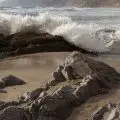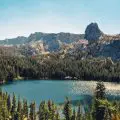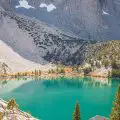Hey! This site is reader-supported and we earn commissions if you purchase products from retailers after clicking on a link from our site.
Located just south of Big Sur Station, Monterey County, this unique and famous purple sand beach, with violet hues of sand bleeding beautifully across Pfeiffer Beach. Sunlight streams through the gap in the magnificent Keyhole Arch. You’ll find many photographers swarming this beach, their cameras poised with steady wrists, one eye shut as they snap away at the marvellous paradise that they’re surrounded in.
Table of Contents
- What Is Pfeiffer Beach?
- Best Time to Visit Pfeiffer Beach
- Why Is the Sand Purple?
- Pfeiffer Beach Hours of Operation
- What to Do at Pfeiffer Beach?
- Things to Do in Big Sur
- Where to Stay in Big Sur, California?
- Purple Sand Beach
- FAQs (Frequently Asked Questions)
What Is Pfeiffer Beach?
Pfeiffer Beach is located in the Big Sur region of California and is one of the most popular beaches on the west coast; well known for Keyhole Arch. Most famous for its purple sand beach, Pfeiffer Beach is an enchanting and preserved destination that is popular with locals, and relatively unknown among Big Sur’s tourists.
The beach has jaw-dropping offshore views of bewitching sea stacks, and rock formations; great waves for surfing. Facing west it is a phenomenal place for sunset photography, especially with the dreamy purple sand beach, adding to the magical atmosphere.
Best Time to Visit Pfeiffer Beach
September to November – the autumn months – is considered to be the best time to visit Big Sur. By this time, summer crowds have dispersed and you can enjoy a less crowded Pfeiffer beach. This part of the coast is often foggy and cold all day, especially during conditions called June Gloom which can happen at any time between May and August.
June Gloom is the term used to emphasize the fact that May and June are the gloomiest months of the year, with mostly cloudy skies, and sunlight appearing almost half of the time.
Visit between November and January if you want to witness the sun seeping through the keyhole arch at sunset; it does rain a lot during the winter and spring, so beware of the split change in weather conditions during this time of year. However, if you’re motivated for visiting Pfeiffer Beach, is purely for the violet spots of sand, then the rain might work to your advantage.
The sand is typically the most purple sand right after the rains, so check the weather a week before you plan to visit Pfeiffer Beach, looking for a sunny day that follows the rainy one. If it’s windy you might find this experience a little unpleasant, as bits of sand flying around the beach, and sticking to your eyeballs might not be the greatest of experiences.
If you plan to take long strolls along the beach, you’ll want to familiarise yourself with the tides before you go. The north part of the beach past the rocks is almost cut off from the rest of the beach at high tide, so look out for tide predictions for the day to avoid getting stuck.
Why Is the Sand Purple?
This precious gem obscured along the Big Sur gets its purple sand beach tinge from the manganese garnet washed down the mountains when it rains. Because of this, you won’t be able to see the purple sand upon every visit, but had there been no purple sand on Pfeiffer Beach, it would’ve still been absolutely gorgeous, especially when you catch the sun setting.
Though I’m sure you’d be determined to catch the purple sand beach, upon your visit to the area – days after rain will give you the violet sand you seek. However, if it is your first time visiting you might find that the color of the sands is a little underwhelming, as the entire beach isn’t blanketed in purple sands.
Despite this touch of disappointment, you might emerge prosperous and find a few stretches of purple sand beneath thin streams of running water, usually collected under trees or plant life. You’ll find more purple sand in the North of the beach alongside tide pools at low tide. Tide pools themself are spectacular to witness.
Pfeiffer Beach Hours of Operation
The famous purple sand beach opens daily from 9:00 am to 8:00 pm, with extremely limited spaces in the parking lot, which happens to fill up very quickly. During the months when tourists like to swarm the purple sand beach, which usually falls between May and September, the car park can be packed within the hour, especially on weekends. The parking lot costs $5 an hour.
On weekdays finding a parking lot spot is less competitive, and arriving by 11 am will guarantee you a spot to park alongside some isolated time on the alluring sands of the beach, where you can peacefully set up a picnic, and enjoy a relaxing afternoon.
Check the weather conditions before you arrive at the beach, and there is also an entrance fee of $10, which is cash only. From the car park, you can take a short walk down to the beach and the Sycamore Canyon Creek empties into the pacific, you’ll spot a rock point that protects some of the sand at the cove.
What to Do at Pfeiffer Beach?
As one of the most incredible iridescent sights in Big Sur, California, the purple sand beach is the perfect spot for a scenic walk, glimpsing magnificent sceneries, sunbathing, and pretty much marveling at the natural perfection of the world spread around you. Dogs on leashes are also allowed, so you might even choose to bring your dog along for a stroll on the beach, barefooted on the cool wet sand – only if you like sand between your toes.
For swimmers, you can also go for a cool dip, bearing in mind that the water is cold, and there are no lifeguards available, so always check the mood of the ocean before taking the plunge. There are lots of rock formations for you to climb, and get an entire view of the beach. Just make sure you’re wearing suitable footwear, preferably with strong grips, because naturally, the rocks will be slippery.
In addition to the violet tinge, to the crystal-like sands on the beach, Keyhole Rock or Keyhole Arch, which is the centerpiece of the beach is a grand chunk of nature, that must make it to your gallery. As you trundle along the beach, make a note of the waves gently sloshing through the jagged arch.
The most magical of moments is when the sun starts to descend, especially between November and January, once the sun streams through the gap in the rock, creating a beautiful beam of light. The orange glow of the sun, makes it appear like a mystical doorway to another dimension. As the sun continues its descent, you’ll catch more rays poking through the arch, till they kiss the ocean waves, which darken until they turn completely black.
Things to Do in Big Sur
An approximate 90-mile bumpy coastline in central California, Big Sur is at a point where the Santa Lucia Mountains meet the Pacific Ocean, and where headlights are outshined by breathtaking ocean sunsets, as the state-spanning Highway 1 slows with hairpin turns. Travelers are quickly intrigued with the roadside attractions like Keyhole Rock standing tall and foreboding, followed by 80-foot waterfalls, cascading into the ocean.
Early morning fog, chokes the coast, but burns away by the afternoon, revealing the vibrant atmosphere of redwood canyons and 300-foot ocean cliffs. If you’re wondering what to do in Big Sur, then take a look at the list below:
- Pfeiffer Beach
- Bixby Bridge
- Julia Pfeiffer Burns State Park
- Pfeiffer Big Sur State Park
- Point Lobos State Natural Reserve
- Ragged Point
- Limekiln State Park
- Garrapata State Park
- Partington Cove
Pfeiffer Beach
Slightly off the beaten path, with narrow and winding two-mile roads till you reach Pfeiffer Beach otherwise known as purple sand beach. It’s just over a mile south of the entrance of Pfeiffer Big Sur State Park, inaccessible to RVs and trailers.
A short pathway stretches from the car park to an enchanting ocean view unparalleled anywhere else on the coast. With rough hypnotic waves, backdropped by steep Santa Lucia Mountains, the magnificent sea stacks at Pfeiffer Beach cause instant bewilderment.
The main point of attraction at Pfeiffer Beach is Keyhole Rock, extremely admired by tourists, and often photographed. This enormous rock formation has a majestic, and natural arch coated in seawater and sunlight bouncing off of its jagged surface. This is a popular place to soak in the setting sun’s rays of sweeping light, sit on a beach chair and watch the glow through the little arch in the rock; whilst the calm water shivers with the evening breeze.
Bixby Bridge
An iconic symbol of the Big Sur coastline, the Bixby Bridge, is heavily photographed by tourists from across the world for its purple sand beach. Also known as the Bixby Canyon Bridge, this modern pinnacle of engineering was completed in 1932 and miraculously stands 260 feet above Bixby Creek.
Finding a wide enough parking lot spot can be a bit of a challenge, especially if you’re planning to visit the bridge and snap a quick picture – you weren’t the only one with that idea. Multiple viewpoints of the bridge can be accessed, effectively providing many angles for the thousands of cameras pointed at the bridge every weekend.
Julia Pfeiffer Burns State Park
Named after an influential pioneer in Big Sur, Julia Pfeiffer Burns State Park provided elevated landscapes to explore right beside the ocean. Hiking paths like the Ewoldsen Trail navigate a vibrant canyon flourishing with coastal redwoods and Pacific madrone, and the alluring McWay Falls can be seen gushing over 80 feet into the ocean, with a half-mile walk from the car park. Natural occurrences like mudslides and wildfires can alter trail conditions within the park.
Pfeiffer Big Sur State Park
Along the banks of the Big Sur River enclosed by sharp Santa Lucia Mountains, Pfeiffer Big Sur State Park is one of the most popular on the coast. Panoramic scenery surrounds every acre of this state park, especially along the trails that follow the Big Sur River and navigate through enormous redwood groves. Pfeiffer Big Sur State Park has over 150 campground sites that accommodate tents, and RVs along the river.
Wildlife flourishes at Pfeiffer Big Sur, with common sightings including deer, turkeys, a variety of birds, and the occasional bobcat. While the beach might provide long-distance views of the ocean, the beach is inaccessible from Pfeiffer Big Sur State Park. Those who want to dip their toes into the ocean should head to the purple sand beach nearby.
Point Lobos State Natural Reserve
On the Northern end of the Big Sur Coast, Point Lobos is thriving with photographers, SCUBA divers, and an abundance of wildlife. Numerous hiking trails navigate the perimeter and interior of this immensely scenic ocean point, allowing visitors to absorb the luscious meadows and dramatic coastline of the natural reserve. A renowned SCUBA destination, the protected waters surrounding Point Lobos are a habitat for hundreds of sea creatures.
Other common wildlife at the park includes seabirds, many of which can be spotted hanging about at the aptly named Bird Island. Point Lobos was once the site of an 1800s whaling and abalone business, remnants of which can be seen and learned about at Whalers Cove. A crown jewel of the California state park system, Point Lobos encompasses a vast amount of habitat that easily attracts the weekend crowds.
Ragged Point
Ragged Point is often the first stop for tourists heading north when traveling through Big Sur. Offers a gourmet restaurant, coffee bar, and pleasant places to stay at night. Ragged Point Inn also offers phenomenal seascapes and a steep trail that descends to a black sand beach. Traveling from San Simeon fifteen miles to the south, tourists also have the opportunity to glimpse the impeccable wildlife habitat within the Piedras Blancas State Marine Reserve.
Outlining this protected portion of the coast a roadside elephant seal rookery provides access and spots to view hundreds of very large and very loud elephant seals, in their natural habitat. North of Ragged Point, Salmon Creek Falls is a mesmerizing water feature accessed from the Salmon Creek Trailhead.
Limekiln State Park
Encircling redwood forests, and the dramatic nature of the Santa Lucia Range spreading out into the ocean, Limekiln State Park highlights much of what makes Big Sur so special. Adjoining the Ventana Wilderness within the Los Padres National Forest, Limekiln State Park offers plenty of things to do, from trails to hike, to campsites, as well as tumbling waterfalls and sweeping coastal views.
Garrapata State Park
Towards the north of the Big Sur coast, Garrapata State Park offers beach access, coastal canyon hiking trails, and outstanding headland views, which are accessible through various pullouts on Highway 1, Garrapata Beach is on the south end of the park near mile marker 17 and 18. Farther north, inland hiking trails explore up and down Soberanes Canyon.
The hiking trail that expands onto Sobranes Point is much less crowded compared to other state parks in the area, providing some of the thickest waves with the best views of the Big Sur coast.
Partington Cove
Two miles north of Julia Pfeiffer Burns State Park, Partington Cove offers a coastal canyon route to the ocean. Parking on a large sweeping curve of Highway 1, tourists cross the road towards a large metal gate to hike the curving forest road down to Partington Cove. After a steep mile heading downhill, a historic 60-foot tunnel reveals some of the tanbark histories of the cove, with the tranquil waters appearing shortly after exiting the tunnel.
Where to Stay in Big Sur, California?
To soak in the beauty of Big Sur, consider booking a few nights at the elegant Post Ranch Inn. With rooms, suites, and house rentals that blend beautifully into the coastal environment. It’s a popular place for couples to spend a couple of nights curled up in comfy beds, with the sound of the ocean just inches away. This boutique hotel offers several amenities like fine dining and spa services to enjoy without leaving the property.
The Ventana Big Sur is a luxurious wilderness resort that caters to every aspect of a relaxing vacation. Several of the resorts’ marvelous rooms, suites, and private homes have unique amenities like outdoor showers or hot tubs. You can take part in yoga classes, meditation workshops, and daily Sunset Hours on the public patio.
The Big Sur River Inn is amongst the area’s oldest hotels, celebrating over 80 years in the region. Today, it’s a central tourist spot along the Big Sur River and an incredible stopover for many road trip vacations. Big Sur River Inn offers quaint guest rooms and riverside suites. All overnight accommodations have a somewhat comforting sensation surrounded by woodland. In immediate proximity are an adjacent restaurant, general store, and gas station.
Fernwood Resort is a budget-friendly hotel, offering the best of values. The resort provides a range of overnight accommodations, including motel rooms, forest cabins, and adventure tents. Standard campsites are also available; a grocery store on the premises is a central place for snacks and supplies while visiting, and a site grill offers heartier meals.
Purple Sand Beach
Visiting Big Sur California for the infamous purple sands might just make your entire weekend. But there are areas outlining Pfeiffer Beach that are also worth exploring, whilst catching glimpses of the incredible ocean in the distance. Light drizzles of trickling water from waterfalls are enough to lure tourists to locations like Mcway Falls, so that you can stand fixated on the clear waters hitting the bottom, gently spraying your cheeks.
Though the obsession with the purple sands of Pfeiffer Beach may never fade, it’s worth becoming acquainted with the serene views that accompany the mesmerizing beach.
FAQs (Frequently Asked Questions)
What is Purple Sand Made of?
Purple sand is mostly composed of garnet, which is found in the hills that surround the beach, so when rain falls it creates purple sand hues on the sand.





